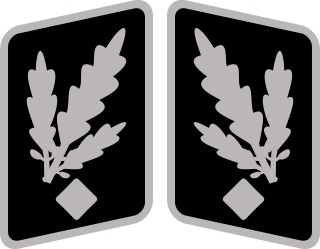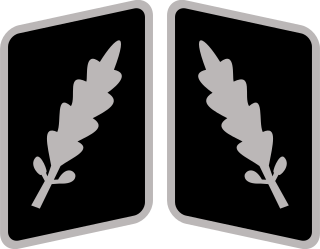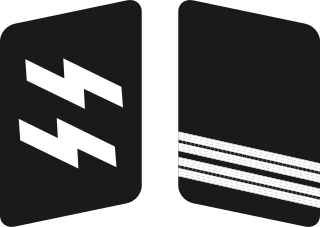The Sturmabteilung was the original paramilitary wing of the Nazi Party. It played a significant role in Adolf Hitler's rise to power in the 1920s and 1930s. Its primary purposes were providing protection for Nazi rallies and assemblies, disrupting the meetings of opposing parties, fighting against the paramilitary units of the opposing parties, especially the Roter Frontkämpferbund of the Communist Party of Germany (KPD) and the Reichsbanner Schwarz-Rot-Gold of the Social Democratic Party of Germany (SPD), and intimidating Romani, trade unionists, and especially Jews.

Gruppenführer was an early paramilitary rank of the Nazi Party (NSDAP), first created in 1925 as a senior rank of the SA. Since then, the term Gruppenführer is also used for leaders of groups/teams of the police, fire departments, military and several other organizations.

Obergruppenführer was a paramilitary rank in Nazi Germany that was first created in 1932 as a rank of the Sturmabteilung (SA) and adopted by the Schutzstaffel (SS) one year later. Until April 1942, it was the highest commissioned SS rank after only Reichsführer-SS. Translated as "senior group leader", the rank of Obergruppenführer was senior to Gruppenführer. A similarly named rank of Untergruppenführer existed in the SA from 1929 to 1930 and as a title until 1933. In April 1942, the new rank of SS-Oberst-Gruppenführer was created which was above Obergruppenführer and below Reichsführer-SS.

The uniforms and insignia of the Schutzstaffel (SS) served to distinguish its Nazi paramilitary ranks between 1925 and 1945 from the ranks of the Wehrmacht, the German state, and the Nazi Party.

Obersturmbannführer was a paramilitary rank in the German Nazi Party (NSDAP) which was used by the SA (Sturmabteilung) and the SS (Schutzstaffel). The rank of Obersturmbannführer was junior to the rank of Standartenführer, and was equivalent to the military rank of Oberstleutnant in the German Army.

Standartenführer was a Nazi Party (NSDAP) paramilitary rank that was used in several NSDAP organizations, such as the SA, SS, NSKK and the NSFK. First founded as a title in 1925, in 1928 it became one of the first commissioned NSDAP ranks and was bestowed upon those SA and SS officers who commanded a unit known as a Standarte, a unit equivalent to an army battalion and comprising 300–500 personnel.

Oberführer was an early paramilitary rank of the Nazi Party (NSDAP) dating back to 1921. An Oberführer was typically an NSDAP member in charge of a group of paramilitary units in a particular geographical region. From 1921 to 1925, the phrase Oberführer was used as a title in the Sturmabteilung (SA), but became an actual SA rank after 1926.

Scharführer was a title or rank used in early 20th Century German military terminology. In German, Schar was one term for the smallest sub-unit, equivalent to a "troop", "squad", or "section". The word führer simply meant "leader".

The Supreme SA Leader, was the titular head of the Nazi Party's paramilitary group, the Sturmabteilung (SA).

Stabschef was an office and paramilitary rank in the Sturmabteilung (SA), the paramilitary stormtroopers associated with the Nazi Party. It was a rank and position held by the operating chief of the SA. The rank is equivalent to the rank of Generaloberst in the German Army and to General in the US Army.

Obersturmführer was a Nazi Germany paramilitary rank that was used in several Nazi organisations, such as the SA, SS, NSKK and the NSFK.

Sturmmann was a Nazi Party paramilitary rank that was first created in the year 1921. The rank of Sturmmann was used by the Sturmabteilung (SA) and the Schutzstaffel (SS).

Rottenführer was a Nazi Party paramilitary rank that was first created in the year 1932. The rank of Rottenführer was used by several Nazi paramilitary groups, among them the Sturmabteilung (SA), the Schutzstaffel (SS) and was senior to the paramilitary rank of Sturmmann.
Haupttruppführer was a Nazi Party paramilitary rank that existed between the years of 1930 and 1945. Haupttruppführer was mainly used as a rank of the Sturmabteilung (SA), but was also used by the Schutzstaffel (SS) in the early days of that group's existence.

Oberscharführer was a Nazi Party paramilitary rank that existed between 1932 and 1945. Oberscharführer was first used as a rank of the Sturmabteilung (SA) and was created due to an expansion of the enlisted positions required by growing SA membership in the late 1920s and early 1930s. The SA rank of Oberscharführer was senior to Scharführer and junior to the rank of Truppführer.
Staffelführer was one of the first paramilitary ranks used by the German Schutzstaffel (SS) in the early years of that group's existence. The later SS rank of Staffelführer traces its origins to the First World War, where the title was used by commanding officers of the Deutsches Heer's Luftstreitkräfte aircraft squadrons initially named as Feldflieger Abteilung as observation-only units in 1914, and during 1916, became known as Staffeln.

Ranks and insignia of the Nazi Party were paramilitary titles used by the National Socialist German Workers' Party (NSDAP) between approximately 1928 and the fall of Nazi Germany in 1945. Such ranks were held within the political leadership corps of the Nazi Party, charged with the overseeing of the regular Nazi Party members.
National Socialist paramilitary ranks were pseudo-military titles which were used by the Nazis, represented by the Nazi Party, the National Socialist German Workers' Party, between the years of 1920 and 1945. Since the Nazi Party was by its very nature a paramilitary organization, by the time of the Second World War, several systems of paramilitary ranks had come into existence for both the Nazi Party itself and the various Nazi paramilitary organizations.

The National Socialist Flyers Corps was a paramilitary aviation organization of the Nazi Party.














































